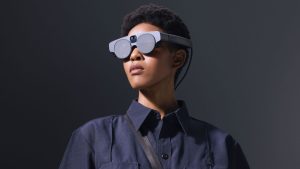Uncertainty. Peggy Johnson, Magic Leap’s new CEO, announced a dramatic transformation in 2020. “Nothing was damaged,” she assured the journalists. “It just required more emphasis.”
 Photo Credit: Magic Leap
Photo Credit: Magic LeapFrom the outside, it was classic CEO-speak. Things weren’t functioning, and that’s hardly rocket science. It wasn’t about the technology. Magic Leap’s mixed reality headsets are impressive. The product felt futuristic at CES this week.
The consumer market for a $2,300 mixed-reality headset wasn’t there. It did what any well-funded, failing corporation does. Magic Leap refocused. It chased the same enterprise audience as Microsoft and Epson.
This week’s exhibition floor featured the pivot. The demos weren’t games; they were genuine applications. In one, a 3D brain scan suggests medical applications. Another shows a mountain. A wildfire moves forward. Above, small helicopters circle.
CTO Daniel Diez tells TechCrunch the move began late in 2019. The financial slump of the past three years has rendered $1,000+ in luxury electronics unaffordable for the typical customer.
Diez says that enterprises understood AR’s usefulness sooner. “They said that. It also showed us how to make Magic Leap 2 enterprise-ready.
While others, like Meta and HTC, are trying to be all things to all people in terms of content, Magic Leap seems in no rush to get its systems into more users’ hands – or at least not to make the necessary hardware sacrifices.
Julie Larson-Green, CTO, sees enterprise potential. “On the consumer, you need another consumer content business, really. So we’re not focusing on that currently.”
The company’s funding has garnered more headlines than any content or hardware in recent weeks. Saudi Arabia’s public investment firm bought a majority interest at year’s end. The company previously raised $3.5 billion from GV, Alibaba, and Qualcomm. Public problems and significant financing have raised worries about Magic Leap’s future.
Diez says, “We’re lucky to have a solid investor base. They align with our aim of focusing on enterprise and ensuring devices can help people perform complex things. Our board and financiers agree.”